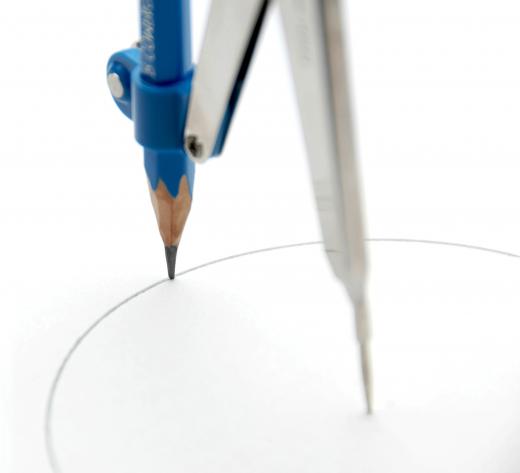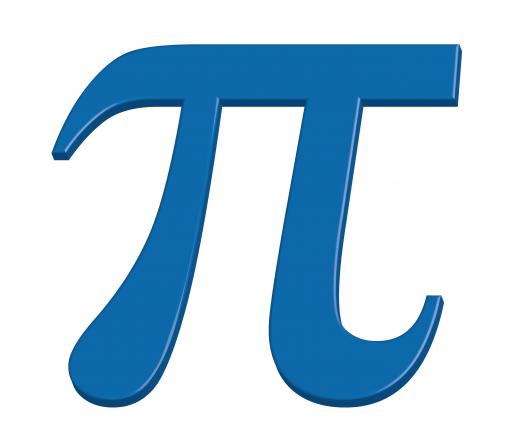What is Pi?
 Mary Elizabeth
Mary Elizabeth
Pi is the 16th letter of the Greek alphabet, but it is best known as the symbol used to name a mathematical relationship: the ratio between the circumference of a circle and its diameter. As such, it is a mathematical constant and has many uses. Most obviously, it can be used to calculate the circumference of a circle from its diameter and vice-versa. Other examples are the formulae to find the area of a circle and the volume of a sphere. It is often represented by the Greek form of the letter, π, and is commonly given the value 3.14; however, this is only an approximation, and the number has some fascinating properties.
Value

The precise value of pi cannot be stated. No fraction is exactly equivalent to it and when it is expressed as a decimal, there are an infinite number of digits after the decimal point. Therefore, whenever it is required for a calculation, an approximation has to be used. The value employed depends on how precise the calculation needs to be.
For some purposes, 3.14 is acceptable, while for others, a value correct to, say, eight decimal places — 3.14159265 — might be required. No calculations require a value accurate to more than 40 decimal places. Many people have used computers to perform record-breaking calculations of the value of π; as of 2013, it has been calculated to 10 trillion decimal places. There is, however, no conceivable application that requires such an accurate value.
Uses

Although pi is defined in terms of the diameter of a circle, in mathematical formulae, it is normally the radius, represented by "r," that is used, so that the formula for the circumference of a circle is 2πr, or radius multiplied by π times two. Other common mathematical formulae using π include the following:
- the area of a circle — πr2
- the surface area of a sphere — 4πr2
- the volume of a sphere — 4/3πr3
The constant is also used extensively in
, statistics and
.
Properties

Pi is an irrational number, which means that it cannot be expressed as a ratio, or fraction, involving two integers, such as 2/5 or 7/3. Some fractions are close approximations, for example, 355/113 gives the number correct to 6 decimal places; however, an exact value cannot be obtained this way. When irrational numbers are expressed as decimals, the digits after the decimal point form an infinite, non-repeating, sequence.
It is also a transcendental number, meaning that it cannot be a root, or solution, to any algebraic equation with rational coefficients. The coefficients of an equation are simply the numbers that prefix the symbols; where there is no numeric prefix, the coefficient is 1. For example, in the equation 3x + y = 0, the coefficients of x and y are 3 and 1, respectively. The fact that pi is transcendental is proof that the ancient problem of “squaring the circle” — constructing a square with the same area as a circle using only a straight edge and a compass — is insoluble.
The sequence of digits after the decimal point appears to be random. Many attempts have been made to find patterns within this number, but all have failed. The randomness has not been proved but, as of 2013, the sequence, as far as it has been calculated, passes all tests for it.
History
The ancient Babylonians and ancient Egyptians both used rough approximations of π, calculating values a little over 3.1. Archimedes, the ancient Greek mathematician, found that the value lay between 223/71 and 22/7. Pi was found to be irrational in 1770 by the German mathematician Johann Lambert, and in 1882, the physicist Ferdinand Lindemann showed that it is a transcendental number. In more recent years, the value has been calculated to an ever-increasing number of decimal places — a trend that looks set to continue with the growth of computing power.
Interesting Facts about π
If the sequence of digits after the decimal point in π is random, this means, since it is also infinite, that every conceivable sequence of numbers, no matter how long or unlikely, must occur somewhere in the series. In fact, each must occur an infinite number of times. The digits can be used to represent other characters, such as letters of the alphabet and punctuation marks. In this way, every conceivable sequence of characters could, in theory, be found within pi by searching through a sufficient number of digits. These sequences would include the complete works of Shakespeare, all known mathematics textbooks and this article, as well as an infinity of books that have not yet been written.
To find anything meaningful more than just a few characters long would, however, require the calculation of pi to an unimaginable number of decimal places, many orders of magnitude greater than the current record. As of 2013, it is possible for anyone, using a simple online program, to search for character strings in the first four billion digits of π. The likelihood of finding a character sequence of a given length is easily calculated. For example, the probability of finding a given ten-character sequence in the first four billion digits of pi is 0.0003%.
So far, nothing that appears meaningful has been found in pi. There is, however, a sequence of six consecutive 9s, starting at the 762nd digit. This is known as the Feynman point and is named after the physicist Richard Feynman. Its probability of occurring so early in the sequence is 0.0685%; nevertheless, it is thought to be simply a freak occurrence.
Many people have succeeded in memorizing π to a huge number of decimal places. As of 2013, the record is considered to be 67,890. The date 14 March (also written 3/14) has been designated “Pi Day” in the USA, with various pi-related activities taking place. Music based on this constant has been created and novels have been written where the word lengths are the digits of π in the correct sequence.
AS FEATURED ON:
AS FEATURED ON:













Discussion Comments
@clintflint - I think it came from being a kind of exclusive indicator that you were a particular kind of math geek, and spread over the internet until people thought knowing anything about pi got you into the club.
There are a lot of people who find the idea of ratios interesting, particularly pi and the golden ratio and the different implications of them and the numbers and shapes that can be generated from them. I'm one of those people, although I do confess I know very little about them.
Then, there are people who just like the fact that a wizz-bang maths buzz word has the same meaning as a popular dessert. There is some overlap between the two groups, of course, but generally, most people only fit into the second category.
It's interesting how many people like to brag that they have been memorizing pi to so many digits. It seems kind of cute and quirky to me, but considering how easily the human brain can memorize things, you'd have to get quite high before I'd be impressed. And even then, I'd be more impressed if you had memorized something like the whole text of Romeo and Juliet or something that might actually be of use some day.
Do what makes you happy, of course. But don't expect people to be astonished that you can recite a lot of numbers off by heart, when everyone has managed to remember all 200 words (I'm guessing) of the national anthem by the time they are five.
I think that the name pi, as well as what it simply is, a number, lead to its popularity because it allows people to know what it is.
Now, I guarantee that most people do not know how to apply the value of pi in a mathematical equation, but I also guarantee that most people know what pi is and at least have a basic understanding of what it is used for.
It is quite amazing what type of following it has, and I would really like to learn of the origins behind the following of pi, pi day, as well as all the pop culture references to pi and the merchandise that depicts the symbol for pi.
To my understanding, there is in fact a pi day in which people all around the world have contests to see how many correct digits of pi they can recite from memory.
I read that Pi has over 200 million numbers!
i am doing pi in math and it's awesome.
Pi actually has infinite digits. As for how far it has actually been calculated to, I believe it is somewhere over 9 trillion.
I read online that it has over 5 trillion! I don't know if I should believe it but that site hasn't failed me yet.
Pi has more than 707 digits!
I can remember 100 digits. I started remembering 50, but for some reason, it didn't seem to impress anyone. I'm hoping 100 will impress a little more. It took me 10 minutes to remember it, and i made one mistake, after that it stuck.
I have memorized only 18 digits of pi east of the decimal.
I know more than 60 digits of pi!
Post your comments